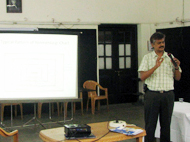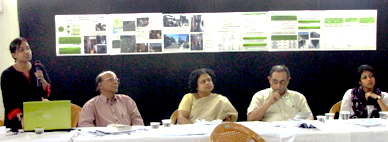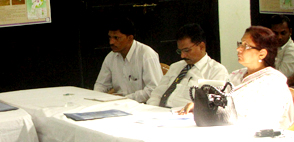Events
Integrated Community Based Flood Risk Identification and Mitigation in Micro Hotspot Dharavi, Mumbai
Date: May 21, 2011
Venue: Sir J.J. College of Architecture, 78/3 JJ College, Mumbai G.P.O (Fort), Mumbai, Maharashtra- 400001, India
Organized by:
Kyoto University Global COE Program "Global Center for Education and Research on Human Security Engineering for Asian Megacities"
Co-organized by:
- School of Planning and Architecture, New Delhi, India
- Municipal Corporation of Greater Mumbai (MCGM), Mumbai, India
- Sir J.J. College of Architecture, Mumbai, India
Number of attendants: 25
Report 161
Content of the Report
Executive Summary of the Workshop (Page 1-5)
Program Schedule (Page 6)
Presentation - 1 : "Welcome Address & Introduction": – B. Misra, Senior Advisor & Coordinator, KU-GCOE Mumbai Project (Page 7-9)
Presentation - 2: "Integrated Disaster Risks Management for Megacity Mumbai" – Subhajyoti Samaddar, Roshni Chatterjee, B. Misra , H. Tatano (GCOE–HSE Mumbai Team) (Page 10-99)
Presentation - 3: "Link between Local Community, NGOs, Voluntary Organizations and District Disaster Management Authority" – P.V.Suresh, Chief Warden, Mumbai Civil Defence (Page 100-109)
Presentation - 4 : "Flood Risk Mapping KDMC using GIS and Remote sensing Techniques" - Sneha Krishnan, Post Graduate Student, Disaster Management Program, Tata Institute of Social Science (TISS), Mumbai, India (Page 110-144)
Presentation - 5: "Analytical And Consensus Building Participatory Tools" - Roshni Chatterjee, GCOE-HSE Project, Mumbai Base, Kyoto University, Mumbai, India (Page 145–187)
List of Contacts (Page 188–189)
Outline
The fourth workshop of the Global COE program, "Global Center for Education and Research on Human Security Engineering for Asian Megacities (GCOE-HSE)", Mumbai base was held at Sir J.J. College of Architecture, Mumbai, India on May 21, 2011. The purpose of this workshop was to identify the future technical and organizational needs and supports required for disaster risk mitigation and preparedness at the hot spot level and to introduce and test the relevance of elsewhere well accepted community based risk assessment and risk reduction tools like "Yonmenkaigi","Self efficiency" & "Collective efficiency" techniques for participatory assessment of hazards, vulnerabilities, capacities to promote public awareness, training and action plan.
Report
In the welcome address Prof. B. Misra, Senior Advisor & Coordinator, GCOE Mumbai Project. thanked the collaborators, MCGM & SPA, and mentioned gratitude to Sir J.J. College of Architecture for co-hosting the workshop.
Misra explained the GCOE Mumbai project (2009-2013), its purpose and objectives related to the implementation strategies of IDRiM in Asian Hotspot Megacity, Mumbai. The first phase of the project, "Knowing the Community" was devoted to understand the community in the selected hot spots through intensive surveys and use of relevant secondary data and information. The second phase, "Working with Community" which is to begin now will be devoted to strengthening network with all stakeholders including the NGOs and the community representatives. The aim of the phase is to work together with community, field test and apply participatory technologies and prepare an integrated disaster risk management plan for a selected hot spot. Also explore methods by which the plan is best integrated with the local general development plan being made by MCGM.
The participants in the workshop stressed on the growing concern over the increased vulnerability of Mumbai enhancing disaster risks. Community based initiatives for addressing social vulnerabilities and participatory approaches were the significant points discussed and it was noted that those remain weak and not effectively organized. Examples of other Asian cities were cited and successful disaster mitigation techniques were discussed for sharing views on good practices. Professionals from the field of Critical Infrastructure and other organizations discussed their visions on Risk Perception and different techniques for community driven action plans in their respective fields. NGOs discussed their roles in the successful implementation of community based techniques in the identified hotspots. Almost 25 participants attended the workshop, bringing together not only university professors, but also a number of practicing professionals. A very significant achievement of the workshop was the participation of community members from the Parshi Chawl, Dharavi, which is one of the selected hotspot in Mumbai where the GCOE team would work with community. The participatory techniques namely ‘yomenkaigi’, ‘self efficiency’ & ‘collective efficiency’ were explained and discussed. The community representatives gave their views regarding their relevance and applicability to field realities. There was consensus that the techniques are useful and should be given the required field test with close participation of community people. The participation of the community people reflected a growing concern for Disaster Risk Reduction.
The workshop was mutually beneficial for GCOE-HSE and the representatives of the various organizations as well as the community people. It provided a common platform to share and exchange ideas between practitioners of different but related fields which eventually proved to be fruitful for the future of Mumbai.

Fig 1: A portrait of the GCOE-HSE Mumbai Workshop – 21st May, 2011
The Workshop
The workshop was divided into the following session topics:
1. Presentation of GCOE–HSE Mumbai Base on Survey findings
2. Brief Presentations of NGOs and other Stakeholders on the Importance of Integrated Disaster Risks Management (IDRiM) in the community
3. Kick-off meeting (Structured Dialogue) on need and support assessment for community driven action plan in micro hotspots
4. Structured dialogue and discussion on - Area and Community selection, Stakeholder identification, Tools introduction and selection including "Yonmenkaigi" System


Fig 2: Prof. Rajiv Mishra, Principle of Sir J.J. College of Architecture explaining to community members in local (Marathi) language
Fig 3 : (From Left to Right) REPRESENTATIVES - Roshni Chatterjee, Urban Planner from GCOE-HSE Program, Prof. B. Misra from GCOE–HSE Program; Prof. Sanjukta Bhaduri, Head of Urban Planning Department, School of Planning and Architecture and Prof. Kavas Kapadia, Dean of Studies, School of Planning and Architecture, Elizabeth Cheeran, Observer Research Foundation (ORF), Mumbai
Session 2
After the welcome speech by Prof. Misra, the second session was opened by Dr. Subhajyoti Samaddar, Post Doctoral Researcher, DPRI, KU, Japan. Dr. Samaddar briefly discussed about the major findings from the first and second round surveys which GCOE-HSE had conducted in the Mumbai micro hotspots. He dealt with the following major topics: Introduction of sample areas namely Premnagar, Parshi Chawl and Rajivgandhi Nagar of Dharavi area, comparative study of social and economic aspects of these three communities and the extent of damage of 2005 Mumbai flood on these communities.
Part 2 of the second session was chaired by P.V. Suresh, Chief Warden, Mumbai Civil Defence. In this session there were brief presentations by NGOs and other Stakeholders on the importance of Integrated Disaster Risk Management (IDRiM) at community. Mr. P.V. Suresh gave a brief presentation on the link between local community, NGOs, voluntary organizations and district Disaster Management Authority at three stages: before disaster, during disaster and after disaster. Mr. Suresh firmly suggested that a disaster response and management system will be successful only by effective mobilization and participation of the community.
Session 3
The third session, which was held post-lunch, was chaired by Dr. Rajiv Mishra, Professor and Principle, Sir J.J. College of Architecture, Mumbai, India. This session was on the topic "The components of community driven action plan for IDRiM". The session was opened by the presentation of Ms. Sneha Krishnan of RedR India (Ex-student of Masters in Disaster Management from Tata Institute of Social science, Mumbai, India). Ms. Krishnan presented in brief, her major findings of her thesis which was on "Flood Risk Mapping in KDMC (Kalyan Development Municipal Corporation) using GIS and Remote sensing techniques". She established, through her presentation, the significance of technology for better risk reduction.
The second part of the third session was dedicated to the "Area and Community selection, Stakeholder identification, Tools introduction and selection, including "Yonmenkaigi" System". Ms. Roshni Chatterjee, Urban Planner, GCOE-HSE Mumbai Base, KU, Japan gave a presentation on the same topic where she introduced three "Analytical And Consensus Building Participatory Tools", namely Self-efficacy and Collective-Efficacy (as Researcher's tools) and Yonmenkaigi System Method or YSM (as Professional's Tool). She explained the human psychology of people at the time of disaster and the aspects that affect their choice of coping alternatives through self-efficacy and collective efficacy. She explained in details the process of Yonmenkaigi System Method (YSM) and cited examples of its application in Japan and Indonesia. She suggested the use of YSM as a possible participatory disaster risk mitigation technique which is basically collaborative action plan.
The third session, which was held post-lunch, was chaired by Dr. Rajiv Mishra, Professor and Principle, Sir J.J. College of Architecture, Mumbai, India. This session was on the topic "The components of community driven action plan for IDRiM". The session was opened by the presentation of Ms. Sneha Krishnan of RedR India (Ex-student of Masters in Disaster Management from Tata Institute of Social science, Mumbai, India). Ms. Krishnan presented in brief, her major findings of her thesis which was on "Flood Risk Mapping in KDMC (Kalyan Development Municipal Corporation) using GIS and Remote sensing techniques". She established, through her presentation, the significance of technology for better risk reduction.
The second part of the third session was dedicated to the "Area and Community selection, Stakeholder identification, Tools introduction and selection, including "Yonmenkaigi" System". Ms. Roshni Chatterjee, Urban Planner, GCOE-HSE Mumbai Base, KU, Japan gave a presentation on the same topic where she introduced three "Analytical And Consensus Building Participatory Tools", namely Self-efficacy and Collective-Efficacy (as Researcher's tools) and Yonmenkaigi System Method or YSM (as Professional's Tool). She explained the human psychology of people at the time of disaster and the aspects that affect their choice of coping alternatives through self-efficacy and collective efficacy. She explained in details the process of Yonmenkaigi System Method (YSM) and cited examples of its application in Japan and Indonesia. She suggested the use of YSM as a possible participatory disaster risk mitigation technique which is basically collaborative action plan.
Final Session
The final session was dedicated to a structured dialogue and discussion on area and community selection, stakeholder identification and identification of tools and techniques. In this session the stakeholders and NGOs discussed the need and support assessment for community driven action plan in micro hotspots and the possible tools that can be applied. Discussions also followed on the possible role of each NGO and stakeholder agency present in the workshop, in the implementation of such community driven action plans.
In this session the community people from Parshi Chawl area actively participated and gave their opinions about the feasibility of YSM or similar participatory action plans in their community.
At the end of the workshop it was decided that YSM would be conducted by GCOE-HSE in Parshi Chawl area of Dharavi and the two NGOs namely, United Way Mumbai and YUVA India agreed to help.


Fig 4: P. V. Suresh, Chief Warden and other delegates of Civil Defense, Mumbai
Fig 5: Local people giving their opinion
Discussions
Sharad Mahajan (MASHAL):
Slums are not expanding but definitely becoming denser. Houses which were ground storey structures in 2006 have changed to G+1 in 2010. Illegal constructions also take place, e.g., 4 storey slums exist in Bandra East in Mumbai. Such slums do not follow BMC height restrictions.
Academicians and researchers are not connected to ground reality emotionally; hence even after researches proper implementation does not take place at the grass root level. More voluntary action is required for slum rehabilitation programs.
Regarding possible role of MASHAL in YSM in Dharavi slums, Sharad Mahajan responded that MASHAL is mainly a Pune based NGO. It delas with several aspects like livelihood issues, training, women empowerment, children education, disasters etc. But MASHAL generally does not work within Mumbai limits; their work is restricted till Pune till now.
Dayanand Jadhav (TPM):
Grass root level action is required for effective Disaster Risk Management like trainings to local people etc.
All community based organizations (CBOs) should be officially registered to avoid any communication gap with community or the Government.
Identifying the required facilities after a disaster becomes a critical aspect in reality. E.g., most of the times food and clothes are more required by affected peolpe in comparison to money or cash.
Distribution of articles from distribution camps often becomes a practical problem after a disaster, due to which proper articles do not reach at places where people actually need them. Example, people needing clothes end up getting food and vice versa.
Dayanand Jadhav (TPM):
Grass root level action is required for effective Disaster Risk Management like trainings to local people etc.
All community based organizations (CBOs) should be officially registered to avoid any communication gap with community or the Government.
Identifying the required facilities after a disaster becomes a critical aspect in reality. E.g., most of the times food and clothes are more required by affected peolpe in comparison to money or cash.
Distribution of articles from distribution camps often becomes a practical problem after a disaster, due to which proper articles do not reach at places where people actually need them. Example, people needing clothes end up getting food and vice versa.
Kavas Kapadia (SPA):
Academicians often find solutions to problems but problems arise during actual implementation of these solutions at the grass root level.
Common sense should be applied while formulating strategies for Disaster Risk Management (DRM). Livelihood loss is a critical aspect of DRM.
Situation may demand both: top-down approach or bottom-up approach, although common people prefer the latter.
Sanjukta Bhaduri (SPA):
Health loss is a major problem that follows any disaster. It is a critical aspect to analyze that how the health loss can be compensated either monetarily or else wise.
In future ward level plans will come up. Recognizing the role of NGOs in such ward level plans will be a very critical aspect in future.
Seema Redkar (MCGM):
Yonmenkaigi System Method (YSM) will be successful if applied in micro-level areas. But for macro level problems or where many stakeholders are involved, YSM may not be the correct tool.
Apart from MCGM, community members themselves should also voluntarily take upon themselves the responsibility of coping with disasters at a local level.
Rajiv Mishra (Professor and Principle, Sir J.J. College of Architecture, Mumbai, India)
Planners should intelligently convince politicians so that the correct plans are implemented.
Ajay Govale (United Way Mumbai):
For effective DRM, a community should identify local key stakeholders and build local-stakeholder partnership.
Social mapping is a critical aspect, e.g., groups having health-related problems after a disaster should be mapped. Also, local youth groups should be mapped and brought to common forum. They can play a very crucial role in DRM.
United Way Mumbai agreed to help GCOE-HSE in whatever ways possible in implementing Yonmenkaigi System Method (YSM) in Dharavi Parhi Chawl.
Bharat Kale (YUVA India):
Yonmenkaigi System Method (YSM) will be successful in Dharavi area.
YUVA India is ready to help if GCOE-HSE wants to implement Yonmenkaigi System Method (YSM) in Dharavi Parhi Chawl.
Comments made by community members:
Regarding impact of flood and role of Government:
Earlier (before 2008) there used to be 6ft-8ft high water during flood in Parshi Chawl area (during 2005 flood). Now, water level during flood has come down considerably. When asked about whether Government helped them during times of such disaster, their general opinion was that Government people would come very late and by this time local people themselves found some temporary coping measures. Moreover, the government representatives would only finish their responsibility by giving their phone numbers to the local people.
Will YSM be successfully implemented in Dharavi?
According to the community members, YSM will be successful if applied within their community (Parshi Chawl area) instead of an extended area. This is because Parshi Chawl is comparatively a smaller area and the local leaders have control over their people. As for the four groups in YSM, community people opined that it would work if the groups are divided as per wards and not as per other conventional functions (like management, communication, human and physical resources).

Fig 6: Representatives from MASHAL , MCGM, CIVIL Defense, YUVA , United Way of MUMBAI , Trishul

Fig 7: Ajaya Govale (middle), United Way of Mumbai, advocating critical contribution of local youth group in IDRiM . Seema Redkar (left), Municipal Corporation of Greater Mumbai and Prof. Rajiv Misra, Principle of Sir J.J. College of Architecture made their critical inputs

Fig 8: Structured dialogue and discussion period
